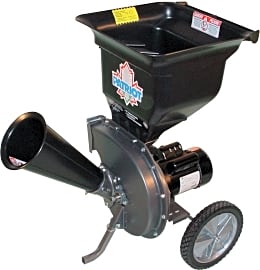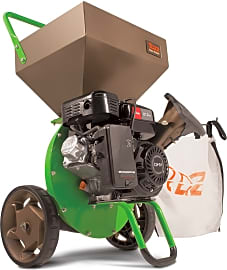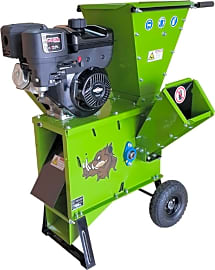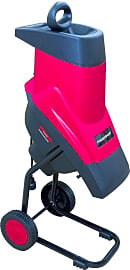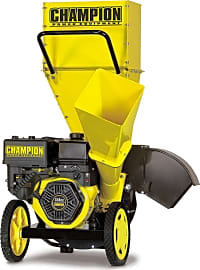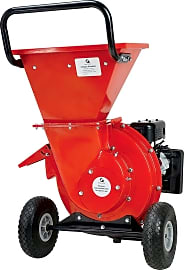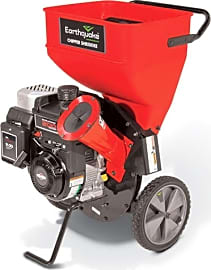The 10 Best Wood Chippers

This wiki has been updated 40 times since it was first published in April of 2015. When it's time for some serious yard cleaning, you can take some of the hassle out of the process with one of these wood chippers and shredders, which can make quick work of all those branches, twigs, and leaves, and are available as electric and gas-powered models, as well as heavy- and light-duty options. Just remember to take the necessary safety precautions (we've all seen "Fargo"). When users buy our independently chosen editorial choices, we may earn commissions to help fund the Wiki.
Editor's Notes
May 08, 2019:
Reducing your yard waste to chippings is the best way to take care of it. This allows you to reuse it as mulch if you desire, or at the very least, fit as much as possible into your rubbish bin. We are the first to admit that tiny, electric-powered models are usually woefully inefficient for everything but the smallest of twigs, but if you are determined to buy one of these models, either for lack of storage space or budget constraints, then the Sun Joe CJ602E and Power Smart PS10 are the best of the bunch. The Patriot CSV-2515 deserves special mention though for proving just how capable an electric model can be. In fact, it powers right through dry and green branches that many other models would struggle with. If you regularly need to chip large branches, you will be best served by the commercial-grade Patriot CSV-3100B and YardBeast 2510. While expensive, these models offer a near unrivaled ability to eat through practically anything you drop into their hoppers. Slightly more affordable, but not much less effective for the average homeowner, we have the Tazz 30520, Champion Power Equipment 100137, GreatCircle LCE01, and Yardmax YW7565.
Special Honors
John Deere WC12 Series While certainly overkill for the average homeowner, this model is ideal for farmers, city parks and recreation divisions, and anybody else who needs a model that can handle large-diameter branches and runs continuously day after day. It features an adjustable discharge chute; reversible, hydraulic feed roll; and is available with a variety of attachments. Be aware though, it is designed for use with one of the company's 35- to 115-hp tractors to operate. deere.com
Deciding Which Wood Chipper Works For You
Next consider which type of motor you prefer in a wood chipper, gas powered or electric.
A wood chipper can help reduce huge piles of branches and brambles down to slivers and discs that are easy to remove or repurpose. Pulling out overgrown brush or chopping down a tree are just the start of a landscaping project; breaking down those felled materials so you can enjoy a clean, healthy property is also part of the job.
It's important to understand the capabilities of a wood chipping unit before you make a purchase, as not all units offer the same level of processing power. Some genuine wood chippers can chew their way through thick pieces of wood with ease, helping you to break down branches several inches thick. Other units that might be referred to as "wood chippers" are actually intended to chop through leaves, twigs, and more slender sticks and branches. Some such wood chippers are actually more akin to leaf mulchers, in fact. It's not hard to tell which unit will suffice: simply measure the diameter of a number of the branches you need to break down and then compare their average thickness to the size for which a chipper is rated.
Next consider which type of motor you prefer in a wood chipper, gas powered or electric. Gas powered chippers have motors usually rated in terms of horsepower and usually offer more overall power, able to break down larger, tougher branches than their electric counterparts. However several electric chippers have motors rated at 14 amps and higher and can indeed chop up plenty of larger pieces of wood, processing bushes, shrubs, and most sticks with relative ease. And even though many gas powered units might be more powerful than electric chippers, they are also often more of a hassle to operate, necessitating trips to the gas station, proper use of oil ratios, and so on. Electric chippers, on the other hand, can simply be plugged in.
All widely available wood chippers are relatively portable, almost universally featuring two wheels and a post for stability. While you might need a truck to move one of the large, commercial grade chippers used by crews clearing old growth trees or cleaning up entire properties in a single afternoon, the units in the budget range of most homeowners or smaller landscaping companies can be moved by hand. That said, some units are large and cumbersome enough to where you will only want to position them once or twice per lawn care session, and trasnport branches, brambles, and leaves to the chipper instead of moving the machine to the debris piles.
There are pros and cons to choosing a device so large that moving it is an undertaking. While moving the material to be processed to the chipper takes time and effort, the speed at which a larger unit processes debris will usually make up for the time spent repositioning it. And for larger branches, you will need the capacity offered by these bigger chippers anyway -- if you need to break down branches approaching three inches in thickness, you likely shouldn't consider those smaller, more easily portable units.
Safe And Proper Wood Chipper Use
Using a wood chipper is not a dangerous task provided you wear appropriate safety gear and you use the unit responsibly. At the bare minimum, you should wear eye protection and safety gloves when operating a wood chipper. A wood chipper can create fine dust that can irritate the eyes and can occasionally throw out larger pieces of debris that can cause a more serious scratch to the cornea.
Also watch out for certain plants like bamboo, vines, and other fibrous plants which can become snarled in the blades rather then being cut right through.
As for gloves, you will be feeding rough, often sharp brambles into a unit that will pull them from you hands: gloves prevent splinters, scratches, puncture wounds, and cuts. It's also a good idea to wear hearing protection when operating a wood chipper, especially if you will be running the unit for extended periods of time. Many wood chippers operate at a volume range well above the 75 decibel level that can lead to damaged hearing with prolonged exposure, thus ear protection is strongly recommended.
Never try to feed a piece of wood into the unit for which the wood chipper is not rated. Trying to put a four inch thick branch into a chipper designed only for three inch diameter sections can damage or break the motor or else can at least clog up, dull, and crack its blades. Take the time to split larger pieces of wood before you try to process them; otherwise you will ultimately waste much more time (and money) getting your wood chipper repaired or replaced.
Even when you are feeding appropriate material into your wood chipper, make sure you do so slowly and steadily. Feeding too much material into the chipper at once can have the same effect as feeding branches that are too large into the unit. Also watch out for certain plants like bamboo, vines, and other fibrous plants which can become snarled in the blades rather then being cut right through. Plants such as these are best chopped into shorter lengths by hand and then discarded.
Ideas For Using That Natural Mulch
A wood chipper can be used to create a thick, robust mulch consisting of everything from minced leaves to discs of wood to slivers and shreds of brambles and bushes. The resulting mulch is perfect for ground covering that helps slow or stop weed growth and that can help keep established plants healthy.
If your property uses lots of mulch each year, a wood chipper will pay for itself in terms of savings.
When mulch is placed in a thickness of two to three inches over the soil, it keeps the ground cooler and moist, helping the earth retain much of its water and preventing the sun from drying out or overheating the soil. Just make sure to keep mulch at least a foot or so from the stem or trunk of established flowers, bushes, or trees, as a plant gets much of its air exposure where the roots meet the stalk.
As a ground cover, chipped wood is an ideal solution. Unlike finer mulch blends made from leaves, wood chips break down very slowly and will stay intact and in place for many months in most climates. That means money saved on store bought mulch and less effort than you would expend constantly weeding a given patch of garden, planted bed, or the areas lining a walkway or patio. If your property uses lots of mulch each year, a wood chipper will pay for itself in terms of savings.



